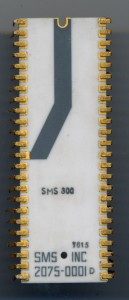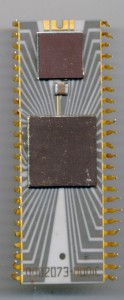 On November 20th, 1969 a small company was formed in Mountain View, CA called Scientific Micro Systems Inc (SMS). They would join the dozens of post-Fairchild semiconductor startups in Silicon Valley. Many of these we remember and know well, Intel, AMD, Zilog, MOS all are familiar and have designed processors that left a story, if not a legacy, in history. SMS has became a forgotten player in the roaring 70’s but they did introduce a few important things to the market. First 4096-bit bipolar Schottky ROM? SMS. First 256-bit bipolar Schottky RAM? Again SMS.
On November 20th, 1969 a small company was formed in Mountain View, CA called Scientific Micro Systems Inc (SMS). They would join the dozens of post-Fairchild semiconductor startups in Silicon Valley. Many of these we remember and know well, Intel, AMD, Zilog, MOS all are familiar and have designed processors that left a story, if not a legacy, in history. SMS has became a forgotten player in the roaring 70’s but they did introduce a few important things to the market. First 4096-bit bipolar Schottky ROM? SMS. First 256-bit bipolar Schottky RAM? Again SMS.
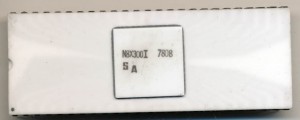
Signetics N8X300I – Early 1978
In January 1975 SMS announced prototypes of their own 8-bit microcontroller. The SMS300 was a non-traditional design. It focused on manipulation of signals. It had 16-bit instructions, but operated on data 8 bits at a time. It had very limited ways of accessing external memory (and no real way to access data memory). It was designed as perhaps the first DSP. It was fabricated in bipolar Schottky transistor technology. This allowed it to be incredibly fast (albeit very power hungry) for its time. Initial clock speeds were 6.66MHz and quickly ramped to 8MHz in 1976. The SMS300 was initially not available for sale as a single chip. It was sold as a single board computer called the SMS330 (as well as the SMS331 and SMS332) which contained everything needed to run the SMS300. This was packaged like a oversized 64pin DIP (similar to how some of the BASIC Stamp microntrollers are today). These systems started at $370 and topped out at $1460. In August of 1975 SMS ‘unbundled’ the SMS300 and began selling it (and its support chips) separately to those who wanted them.
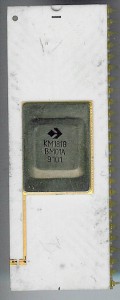
Soviet Electronika KM1818VM01A 8X300 Clone
SMS did not make the SMS300 themselves, they contracted another Silicon Valley company to fabricate them. Signetics, founded in 1961 by ex-Fairchild workers, was the first company founded to solely manufacture ICs rather then discrete transistors. In 1975 Signetics was purchased by Philips but continued to operate under the Signetics trademark until 1993. Signetics made all of the SMS300 devices for SMS, and in 1976 Signetics became a second-source, and could sell the SMS300 under the Signetics brand. By 1978 Signetics had purchased the rights to the SMS300 and renamed it the 8X300. 1977 or 1978 is generally when people think the 8X300 was develped. This is, unfortunately, due to forgotten history as by the time Signetcs bought the design, it had been on the market and in use for over 2 years. Signetics continued to make the 8X300 into the early 1990s where it found wide use in disk controllers, telecommunications and other DSP like environments. The N8X300 was also second sourced by AMD though I have yet to see one. The 8X300 was also *second sourced* by the Soviets in the 80’s and early 90’s by the Electronika state electronics company in what is now Voronezh, Russia. These of course were not licensed copies but they are however, still of interest.
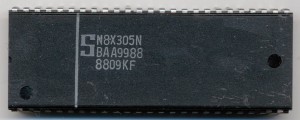
Signetics N8X305N Early 1988
In around 1982 Signetics released the N8X305, the successor to the 8X300. It was functionally compatible but increased the general purpose registers to 13 from 8 among some other instruction improvements that greatly improved upon the data handling deficiencies of the 8X300. Processor speed was also boosted to 10MHz. (200ns instruction time vs 250ns for the 8X300) The N8X305 also used the same pin-out as the 8X300 and the same 50pin DIP package (as well as adding a 68pin PLCC). AMD second-sourced the 305 as the AM29X305. The N8X305 continued to be made into the 1990s and saw use in many military applications as well. Because of this Signetics/Philips could not simply terminate production. They sold production rights to Lansdale Semiconductor Inc., who still offers the N8X305 to this day.

Signetics N8X401I – 1988
In 1986 Signetics again revised the design and released the N8X401. This processor now had a full 32 instruction (including a RETURN instruction allowing the use of subroutines) The N8X401 also added an 8-bit data bus making data handling somewhat simpler but also increasing the package size to a 64 pin DIP. Internal usable registers was increased to 16 and the instruction width was increased to 20-bits. Clock speed remained at 10MHz but it was now fabricated in ECL (Emitter Coupled Logic). This among other improvements, helped to result in a 35% speed boost over the N8X305.
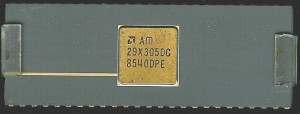
AMD AM29X305DC – N8X305 Second Source – 1985
The N8X401 was not a great success, primarily because of the competition at the time. By 1986 8-bits, even for a DSP, was rapidly becoming out of date, especially with such purpose built DSPs such as the Motorola DSP56000 and the industry standard setting TI TMS320 series.
Thus is the story of one of the most odd processors to come out of the chip boom of the 1970’s (EA 9002, MMI 6701, AMI S2000 et al). There are several other forgotten processors of that era which are also deserving of some remembrance. In time we’ll try to document their history here at the CPU Shack as well.
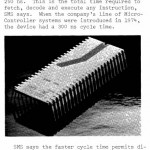 Over two years ago we wrote about the history of the Signetics 8X300 processor. A design that was one of the first DSP like architectures. The 8X300 was a design of the Scientific Micro Systems Inc. SMS300. You can read the entire history here.
Over two years ago we wrote about the history of the Signetics 8X300 processor. A design that was one of the first DSP like architectures. The 8X300 was a design of the Scientific Micro Systems Inc. SMS300. You can read the entire history here.

